Around half of children in Europe and Central Asia – or 92 million – are exposed to high heatwave frequency, according to an analysis of the latest available data from 50 countries published today by UNICEF in a new policy brief. This is double the global average of 1 in 4 children exposed to high heatwave frequency.
"Beat the heat: protecting children from heatwaves in Europe and Central Asia" notes that children are particularly vulnerable to the impacts of heatwaves, putting them at risk of serious illness including heatstroke.
Infants and young children are most at risk during heatwaves as their core temperatures rise significantly higher and faster than adults. Heatwaves also affect children’s ability to concentrate and learn, putting their education at risk, the report notes.
While children are uniquely vulnerable to the impact of heatwaves, most adults experience heat differently, making it hard for parents and caretakers to identify dangerous situations or symptoms of heat-related illness in children, putting children’s health at further risk.
“Countries across Europe and Central Asia are feeling the heat of the climate crisis, and children’s health and well-being are suffering the most,” said Regina De Dominicis, Regional Director for UNICEF Europe and Central Asia.
“Half of children across the region are now exposed to high heatwave frequency. This is expected to rise to all children in 2050. The multitude of negative implications on the current and future health of such a significant proportion of the region’s children must be a catalyst for governments to urgently invest in mitigation and adaptation measures,” said De Dominicis.
In recent years, heatwaves in Europe and Central Asia have become more frequent, with no signs of abating. Across the region, the frequency of heatwaves is set to increase even further over the coming years. Under the most conservative global temperature increase scenarios of 1.7 degrees Celsius, all children in Europe and Central Asia will be exposed to high heatwave frequency by 2050, 81 per cent are estimated to be exposed to high heatwave duration and 28 per cent are expected to be exposed to high heatwave severity.
To help protect children, UNICEF urges governments across Europe and Central Asia to:
- Incorporate heatwave mitigation and adaptation into National Determined Contributions (NDC), National Adaptation Plans (NAP), and Disaster Risk Reduction and disaster risk management policies, keeping children at the centre of all plans.
- Invest in primary health care to support prevention, early action, diagnosis, and treatment of heat-related illness among children, including training community health workers and teachers.
- Invest in national climate early warning systems, carry out local environmental assessments, and support emergency preparedness and resilience building initiatives.
- Adapt water, sanitation and hygiene, health, education, nutrition, social protection and child protection services to cope with the impacts of heatwaves.
- Ensure adequate financing to fund interventions that protect children and their families from heatwaves.
- Equip children and young people with climate change education and green skills training.
Science shows that increased temperatures are a result of climate change. UNICEF urges governments across Europe and Central Asia to reduce CO2 emissions to limit global warming to 1.5 degrees Celsius and double adaptation funding by 2025.

